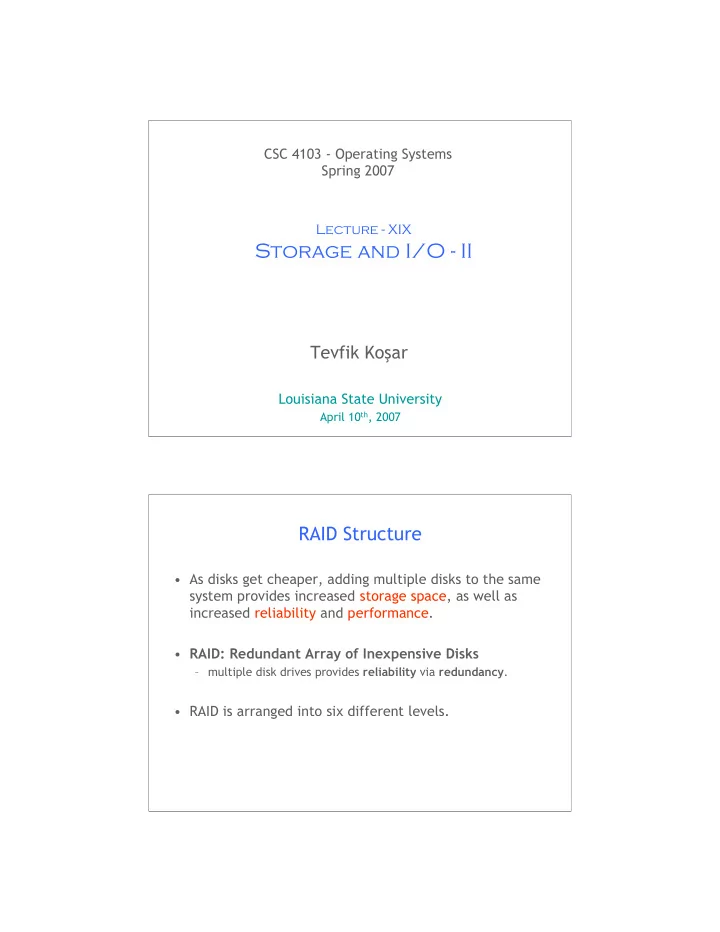

CSC 4103 - Operating Systems Spring 2007 Lecture - XIX Storage and I/O - II Tevfik Ko ş ar Louisiana State University April 10 th , 2007 1 RAID Structure • As disks get cheaper, adding multiple disks to the same system provides increased storage space, as well as increased reliability and performance. • RAID: Redundant Array of Inexpensive Disks – multiple disk drives provides reliability via redundancy . • RAID is arranged into six different levels.
RAID (cont) • RAID schemes improve performance and improve the reliability of the storage system by storing redundant data. – Mirroring (shadowing): duplicate each disk • Simplest but most expensive approach – Block interleaved parity uses much less redundancy. – Data Striping: splitting each bit (or block) of a file across multiple disks. RAID Levels
RAID (0 + 1) and (1 + 0) Hierarchical Storage Management (HSM) • A hierarchical storage system extends the storage hierarchy beyond primary memory and secondary storage to incorporate tertiary storage — usually implemented as a jukebox of tapes or removable disks. • Usually incorporate tertiary storage by extending the file system. – Small and frequently used files remain on disk. – Large, old, inactive files are archived to the jukebox. • HSM is usually found in supercomputing centers and other large installations that have enormous volumes of data.
Hierarchical Storage Management I/O Hardware
Mapping I/O Ports to Memory Polling • Determines state of device – command-ready – busy – Error • Busy-wait cycle to wait for I/O from device
Interrupts • CPU Interrupt-request line triggered by I/O device • Interrupt handler receives interrupts • Maskable to ignore or delay some interrupts • Interrupt vector to dispatch interrupt to correct handler – Based on priority – Some nonmaskable • Interrupt mechanism also used for exceptions Interrupt-Driven I/O Cycle
Intel Pentium Processor Event-Vector Table Direct Memory Access • Used to avoid programmed I/O for large data movement • Requires DMA controller • Bypasses CPU to transfer data directly between I/O device and memory
Six Step Process to Perform DMA Transfer Kernel I/O Subsystem • Scheduling – Some I/O request ordering via per-device queue – Some OSs try fairness • Buffering - store data in memory while transferring between devices – To cope with device speed mismatch – To cope with device transfer size mismatch – To maintain “copy semantics”
Device-status Table Sun Enterprise 6000 Device-Transfer Rates
Kernel I/O Subsystem • Caching - fast memory holding copy of data – Always just a copy – Key to performance • Spooling - hold output for a device – If device can serve only one request at a time – i.e., Printing • Device reservation - provides exclusive access to a device – System calls for allocation and deallocation – Watch out for deadlock Error Handling • OS can recover from disk read, device unavailable, transient write failures • Most return an error number or code when I/O request fails • System error logs hold problem reports
I/O Protection • User process may accidentally or purposefully attempt to disrupt normal operation via illegal I/O instructions – All I/O instructions defined to be privileged --> I/O must be performed via system calls • Memory-mapped and I/O port memory locations must be protected too I/O Requests to Hardware Operations • Consider reading a file from disk for a process: – Determine device holding file – Translate name to device representation – Physically read data from disk into buffer – Make data available to requesting process – Return control to process
Life Cycle of An I/O Request Performance • I/O a major factor in system performance: – Demands CPU to execute device driver, kernel I/O code – Context switches due to interrupts – Data copying – Network traffic especially stressful
Improving Performance • Reduce number of context switches • Reduce data copying • Reduce interrupts by using large transfers, smart controllers, polling • Use DMA • Balance CPU, memory, bus, and I/O performance for highest throughput Any Questions? Hmm.. 26
Reading Assignment • Read chapter 13 from Silberschatz. 27 Acknowledgements • “Operating Systems Concepts” book and supplementary material by Silberschatz, Galvin and Gagne. 28
Recommend
More recommend